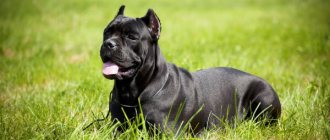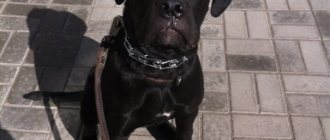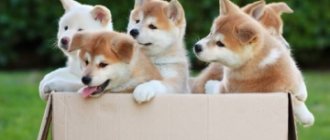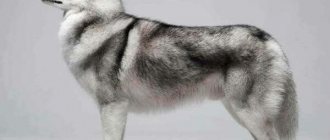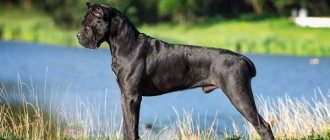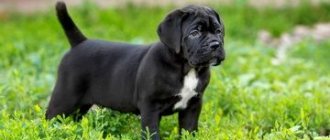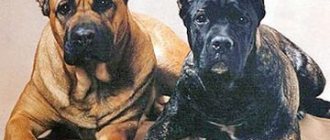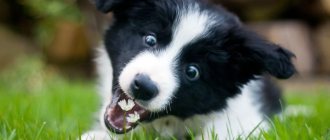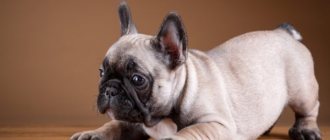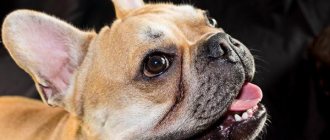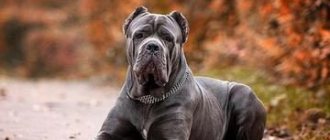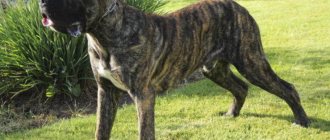The Cane Corso breed embodies natural grace and beauty, in addition, the animal is unconditionally devoted to its owner.
Information about Molossian breeds comes from ancient history, which also mentions the affection and loyalty of these dogs to people.
Italian Cane Corsos are considered the most ancient of the Molossians.
To choose a dog of this breed, you need to find out more information about the animal, its weight parameters, height and character traits.
Adult dog weight
Cane Corso is a rather large dog. Traditionally, males are slightly larger than females.
So, if we talk about the height at the withers of dogs, then their parameters will be as follows:
- height of males – 64-68 cm;
- height of females is 60-64 cm.
Accordingly, there is a difference in weight, which is approximately 5-10 kg.
A male dog has a body weight of 45-50 kg, and sometimes more. Female – 40-45 kg.
If the readings are lower, it means something is wrong with your pet; it would be a good idea to take him to the veterinarian.
Expert opinion
Kozhevin Semyon Kirillovich
Expert dog handler.
“Males can reach a weight of 42 kg and above, females from 38 to 45 kg. But a dog's weight alone cannot be an indicator of health. It is worth paying attention to your pet’s coat, its activity, appetite, etc. We also need to take into account the fact that dogs can gain weight in the winter and lose it in the summer.”
History of the breed
The first mentions of Molossian-type fighting dogs date back to ancient times in Rome. Italian cynologists believe that it is the Cane Corso breed that is of particular value among all Molossians. The dogs, incredibly similar to modern Italians, were used in gladiatorial combat and hunting.
The first written mentions of the breed date back to 1238. Historians have found the coat of arms of the aristocratic de Corsi family, which depicts a dog resembling a modern canoe. There is a theory according to which the name “Cane Corso” originated in Corsica. Another theory is that it comes from the Latin cohors, which translates to “to guard.”
Regardless of where the name came from, Corso working dogs were used in all walks of life - they guarded territories, helped in hunting, herded cows and pigs. An equally important task of the ancient Molossians was the protection of food convoys.
During World War II, the standard of living of the population dropped significantly, and the Cane Corso population declined sharply. Some individuals remained alive among farmers and shepherds in Italy. Through the efforts of fanatical breeders, the breed was revived from a pair of purebred representatives.
In 1984, the dog breed society adopted a breed standard drawn up by Antonio Morsiani. The Italian Kennel Club compiled a stud book, which included records of more than 500 representatives. By 1994, the Kennel Club officially recognized the standard. The Fédération Cynologique Internationale included the breed in its standards in 1996.
Puppies 1-4 weeks old
Puppies are born weighing approximately 350 to 700 grams . (data from tables of the average animal) .
They grow quickly and already on the 15th day, that is, after two weeks, they weigh 1200-1500 grams. The weight of a monthly Cane Corso is already approaching 4-6 kg.
At 30-45 days, the puppy’s growth reaches 25 cm.
Such indicators will be important for purebred Cane Corsos that are being prepared for various exhibitions.
For example, if a show dog exceeds the standards in weight and height, then his points will be reduced.
Read about breed standards here.
It’s not difficult to develop a chart for a dog’s height and weight if you know who the puppy’s parents are..
Feeding Cane Corso: what and how much to feed puppies
What to feed?
Most breeders with large nurseries prefer to feed young animals with ready-made wet or dry food . They contain all the necessary vitamins, are perfectly absorbed and are eaten with appetite by babies. Until the age of two months, elite Cane Corso puppies are with their mother, but they stop receiving mother’s milk as early as a month and a half. The breeder tries to ensure that by the time the pet moves to a new home, it completely switches to independent feeding.
The owner who plans to
feed his acquired friend natural food must definitely find out from the breeder the brand of food the baby was on.
In the first week after moving, the new resident should receive his usual food, and only then can he be switched to a different type of food or another brand of food. This is necessary to minimize the stress received when parting with the mother and new living conditions.
It is ideal if the owner raises the dog on ready-made super-premium food appropriate for the dog’s age, rather than feeding the Cane Corso puppy the leftovers of his meal. Such feeds contain all the minerals and vitamins necessary for proper growth, and they are perfectly balanced in protein content.
Natural food is considered the most suitable for dogs, but the diet for this type of nutrition must be balanced, and vitamin-mineral complexes must be given as a supplement. The puppy's diet should include:
- Meat. Raw beef, boiled turkey, chicken.
- Offal . Liver (can be raw), heart.
- Dairy products. Cottage cheese, milk, kefir.
- Chicken eggs are raw.
- Porridge made from rice and buckwheat with the addition of oatmeal.
- Boiled carrots and cabbage .
- Fresh leaf lettuce .
How to feed?
As a percentage, the share of meat and offal in one serving should be fifty percent: thirty percent is porridge, the remaining twenty percent is vegetables.
Important! You can give cottage cheese to a growing puppy every other day, mixing it with milk or fermented milk drinks. You cannot give cottage cheese every day, as it contains a large amount of calcium.
Calcium is beneficial for a growing puppy, but an excess of this trace element leads to early ossification of growth zones and various pathologies of the musculoskeletal system. For the same reason, puppies up to four months old, before the period of teeth change, should not add calcium supplements to their food.
The portion for a puppy is calculated empirically: a small puppy eats as much as he needs. If the baby does not leave the bowl for a long time after feeding and licks it, then the portion can be increased. If he doesn’t finish eating, then the amount of food is reduced.
The number of feedings for a Cane Corso puppy depends on its age. A two-month-old baby is fed four to five times a day, and by three months they switch to three meals a day. After a year, the young dog is fed twice a day. Infrequent feeding is undesirable, since a large volume of food stretches the stomach and can cause gastric volvulus in older age.
Weight and height from 1 to 12 months
First
Puppies are actively exploring the world. Become more mobile .
At this age, it is already possible to determine the character of the pet; some become restless and inquisitive, while other puppies, on the contrary, are lazy.
During this period they weigh 6-8 kg . The height of a one-month-old puppy is within 25 cm.
Second
During this period, you can gradually wean the puppy away from its mother and siblings.
The baby's curiosity increases, he needs to stick his nose everywhere.
The weight of a 2-month-old Cane Corso is about 9 kg, height is 32 cm.
Third
At this age, learning ability increases.
In addition to remembering its name, the puppy can master simple commands for action.
A dog at three months already weighs a lot, it’s about 13.5 kg.
Height reaches 42 cm at the withers.
Fourth
During this period, the dog tries to dominate, begins to growl and even bite during the game.
Cane Corso already weighs from 16 to 18.5 kg, grows up to 47 cm.
Fifth-sixth
During this period, the animal is already approaching an adult dog; it is worth continuing to train the breed. The cables show signs of sexual activity. At this age, the dog reaches a weight of 22-29 kg and a height of 55-56.5 cm.
IMPORTANT!
In the first five months, the puppy rapidly gains weight and height. In 4 months, the Cane Corso's height at the withers doubles, and its weight almost triples.
Seventh
A dog at this age asserts itself and sometimes shows its character and stubbornness. Sometimes the commands that the Cane Corso previously carried out willingly, he refuses to carry out.
The weight of a 7-month-old puppy already reaches 25 kg and above, and the height remains within 57-58 cm.
Eighth
At this age, dogs become timid. The once familiar street noise can frighten them.
It is worth being patient and waiting out this period without particularly punishing the Cane Corso.
The weight is already approaching the level of an adult, and this is in the range of 33-40 kg, the dog’s height is 59-62 cm.
Two to seven weeks
During this period, the dog’s character is formed and he is ready for simple training. It is already clear who will have the makings of a leader. Depending on this, the method of training for a given period is selected. It is recommended to “push” inactive children to move, and to simply observe and make sure that active children do not harm themselves or spoil valuable things. Under no circumstances should you punish them, otherwise they will grow up fearful or aggressive.
It is important that puppies can have contact with people, then they will treat them normally, and strangers in the house will not cause aggression or fear in the dog.
To what age do they grow?
After a dog reaches puberty, its growth and development do not stop.
Indicators may change up to 3 years.
After this period, the Cane Corso can be called an adult animal.
If you keep a dog for yourself and do not try to send it to various exhibitions, then if you have a good appetite and healthy appearance, it is not necessary to constantly weigh your pet.
Features of caring for Cane Corso puppies, vaccinations
Care
If there is a Cane Corso baby in the house, care for the puppy is minimal, but the owner must examine his pet daily to carry out hygiene procedures. A daily examination helps to promptly notice any change in the pet’s condition, an increase in temperature or an allergic rash on the stomach.
Cane Corso puppies have a smooth, close-lying coat
that needs to be brushed with a rubber brush .
Soft rubber needles remove hairs and massage the skin. You can wash your pet as needed using a mild puppy shampoo. After bathing, the baby is dried with a towel and allowed to dry in a warm room.
Dogs of this breed may have sour eyes in the morning. This is a normal option if the discharge is colorless. The eyes are wiped with a napkin moistened with warm boiled water. If the discharge from the eyes is yellowish or greenish, rinse the eyes with water, and then drop a few drops of chloramphenicol. Levomycetin drops are purchased at a regular pharmacy.
Important! Purulent discharge from the eyes may be a sign of a viral or bacterial disease.
Vaccinations
Puppies up to two months have maternal immunity to most viral diseases. By two months it weakens and babies are vaccinated against major diseases ( plague, hepatitis, enteritis and parvovirus ) with complex vaccines. Ten days before vaccination, the puppy is given a single dose of any anthelmintic drug designed for its age and weight. Vaccination is given only to healthy children.
A booster shot with the same brand of vaccine is given twenty-one days after the first shot to develop a lasting immune response. A single vaccination does not protect the puppy from diseases. For the entire period from the first vaccination to the second plus another two weeks after revaccination, the puppy is in quarantine . This means that the baby is not allowed to have contact with other animals, is not taken outside the yard, and is protected from hypothermia.
Important! Vaccinations should not be given to puppies while their teeth are changing. Many vaccines cause darkening of the enamel of permanent teeth.
, at six months of age, puppies are given another vaccination with a vaccine that protects, in addition to major diseases, from leptospirosis. This vaccination is required in the summer if the puppy swims in bodies of water, but it can be skipped if the dog lives in a private house and does not go outside the yard.
What influences development?
The effect on a puppy's height and weight will depend on different factors at each stage of the dog's life..
So, after birth, the baby feeds on mother’s milk, right now his body must receive all the nutritional vitamins and microelements that will become the basis for the dog’s further development. They will affect the height and weight of the newborn.
Accordingly, the mother will need adequate feeding. Subsequently, the puppy switches to adult food, which will play a fundamental role in the proper development of the dog, both physically and mentally.
This breed has weak joints and ligaments, so during the period of active growth, which is 9–12 months, it is worth making sure that the puppy does not overeat and does not gain more weight than normal.
NOTE!
If the Cane Corso is in good condition, when palpating the body, it is necessary to feel the ribs. But at the same time they should not stick out.
If you use ready-made dry dog food, it will be easier for you to control your pet’s weight gain and growth. If you have any doubts about feeding your dog, you should consult your veterinarian.
In between meals, it is not forbidden to give your pet a little treat, for example, low-fat cheese.
Bowls are placed on a hill at the height of the dog’s elbow. As it grows, the height of the hill also changes.
After a meal, you should not disturb the dog; he should lie down to digest the food he has eaten . If you actively walk your puppy after eating, a stomach volvulus may occur.
Not only proper feeding of a Cane Corso up to 1.5 years old can affect the dog’s weight and height. Physical activity is also important.
The frequency of walks should be as follows:
- for small puppies, walks should be frequent but short so that the baby does not get tired quickly;
- Gradually, the frequency of walking is reduced and the time increases.
- from 6 months, the Cane Corso puppy walks for 20-30 minutes;
- Long walks are taken before meals.
It is necessary to avoid injuries, dose the gaming load, and use vitamin and mineral supplements. All this affects the height and weight of the Cane Corso.
In order to promptly identify problems in the dog’s body, you need to thoroughly examine your pet every day for rashes, allergies or fever..
How to choose the right Cane Corso puppy
Having decided on the question of why a puppy of this particular breed is being purchased and what it is for, the owner comes to the breeder. But how to choose a Cane Corso puppy ?
There are still many cases when a pet is acquired spontaneously, at the first glance at a dog, but this behavior of a potential owner is wrong.
The pet is chosen carefully, meticulously, since the dog will live in the family for ten or fifteen years. A mistake in choice will certainly result in problems and troubles.
The choice of a male or female should not depend on the owner’s reluctance to “endure heat.” The behavior of Cane Corsos of different sexes is very different. Males are much more powerful, stronger and stubborn than females, they tend to dominate, and raising such a serious dog requires physical strength and a strong character. Bitches are people-oriented, family-oriented, affectionate and tolerant towards children.
A few rules for choosing a Cane Corso puppy, or what kind of dog should be:
- Not less than one and a half months. At forty-five days, the livestock specialist examines the litter, and puppy cards are issued for all of them, indicating whether the baby meets the breed standard.
- Smart, independent and sociable. A child with a normal psyche runs up to meet the guests, fusses with littermates and is interested in toys. If the dog sits quietly, not trying to approach, or walks away with its tail between its legs, this is a sign of illness or cowardice.
- Strong. A healthy Cane Corso puppy has a strong body, thick paws, and a large head. Movements are fast, elastic, confident. The coat is shiny. The belly should not be large or distended, and the eyes should not be dull or watery. This is a sign of worms or poor cultivation. A Cane Corso baby's ears are undocked at this age.
What to do if your weight is below normal
An underweight dog indicates health problems. The first thing the owner must do is get his pet’s blood and urine tested.
CAREFULLY!
The most common cause of Cane Corso underweight can be worms.
Perhaps deworming was carried out incorrectly, the wrong drug was selected or the timing of the drug was administered.
If helminthic infestation was not detected, then the cause should be sought in a chronic or inflammatory process in the body.
For a dog of this breed, the problem may be related to the liver or intestinal tract . A veterinarian will help solve all these problems.
Another reason for a puppy’s weight loss is improperly selected food. Everything is not as harmless as it seems.
These circumstances may not have the best effect on the animal’s liver, since such foods contain a lot of protein, which negatively affects the puppy’s growing body..
The young liver is not able to process large amounts of protein, resulting in hepatitis and hepatosis.
Some unscrupulous manufacturers produce low-quality food or put synthetic additives in it that cause addiction in the animal.
As a result, food allergies and liver damage develop.
In this case, you should urgently change the dog’s diet and show your pet to a veterinarian to diagnose the dog’s liver and other internal organs..
Puppy in the first month
When a Corso is just born, all he cares about is sleeping and eating. The only thing the owner needs to monitor is that he does not remain hungry, as well as the puppy’s weight. The baby should recover steadily.
Even if he was born well-fed, this does not mean that he is the strongest and healthiest. If he then gains weight poorly, this is a warning sign. Such a puppy is either malnourished (then the owner’s help in feeding is needed) or is sick. In any case, over time he will begin to lag behind in development.
The weight of a newborn can range from 300 to 700 grams. It depends on the number of brothers and sisters: the more puppies, the more “compact” they are.
After 12 days, babies should fully open their eyes. They still see poorly, and move mainly around each other and up to their mother. They will begin to hear only at the age of three weeks. This can be noticed by observing how puppies begin to react to sounds, especially sharp and loud ones. But they already see well, stand confidently on their feet and can eat soft, porridge-like food themselves.
You may be surprised, but from a month you can already start raising your baby - he is just forming conditioned reflexes. You just need to communicate with him carefully, since now he is the most vulnerable. If the puppy is weaker than other peers, protect him. If he is aggressive, besiege him, but gently.
Obesity in an animal
Obesity is characterized by excessive accumulation of fat as a result of metabolic disorders in the dog's body.
The reasons for this condition are as follows:
- Overfeeding.
- Dietary disorder.
- Insufficient physical activity.
- Hormonal disorders.
Pet treatment
If obesity has developed due to a hormonal imbalance, then it is almost impossible to cure Cane Corso disease.
If the dog is obese as a result of an unhealthy lifestyle, a special diet low in carbohydrates and fats is developed.
It is recommended to gradually increase physical activity, lengthen walks, and play outdoor games with the animal..
A sudden transition to physical activity can undermine the Cane Corso's cardiac activity. In extreme cases, medications are prescribed to reduce appetite.
To prevent Cane Corso obesity, you need to monitor the dog’s diet and walk it more often..
Ear cropping for Cane Corso
In the last few years, changes have been made to the breed standard to allow Cane Corso ears to be uncropped . Moreover, dogs with cropped ears cannot be exhibited at shows in some European countries. Therefore, when purchasing a purebred puppy, it is worth consulting with a breeder or an experienced breeder whether the baby’s ears should be cut.
If the issue rests only on the beautiful appearance ( cropped ears give the dog a more frightening appearance ), then it is better to take pity on the pet. Ear cropping on a Cane Corso is carried out under anesthesia; after the operation, the ears take a long and painful time to heal.
The cut ear needs to be glued so that the cartilage gets used to keeping its shape. Puppies don’t like to walk with an adhesive plaster in the shape of a crown on their heads; they strive to remove the structure. Such stubborn people have to wear a special collar.
Raising a Cane Corso pet is an interesting and rewarding experience. During the time spent caring for the baby, walking him and training him, the friendship between people and the dog grows stronger, mutual understanding and love arise.
Period of perception (4 - 6 months)
By the end of this period, the recommended weight of dogs should be: 24-28 kg for females, 26-32 kg for males.
Having matured, the baby begins to explore leadership in the family, trying not only to growl, but also to bite the owner during active games.
Thus, he is aware of the hierarchy in the family. At this stage, the puppy is formed as a family pet; every family member, including children; must be an authority for the dog, a leader.
After learning the basic commands, training should continue systematically and include more complex tasks..
Most male dogs exhibit high sexual activity, manifested by jumping on the legs of the owner or other dogs.
This is a natural phenomenon for which the pet should not be severely punished (perhaps in the future the owner plans to use the pet as a breeder)
Content
The excellent health of the Cane Corso allows him to get along well in the city and in a private home. The owner needs to monitor the condition of the dog's eyes and ears and clean them regularly.
Need for physical activity
The owner's key responsibility towards the dog is to keep it healthy. Walk your Corso every day for 2 hours a day. To keep your dog entertained while walking, engage in training. Learn the commands “fetch” and “come to me”, and then include more complex exercises. Buy balls and throw them during walks to keep your pet in physical shape.
Walk pregnant Corso bitches three times a day, without giving excessive stress. Nursing mothers will have to be walked 4-5 times a day for 15 minutes.
Appearance care
The Cane Corso's coat, although short, requires care. To maintain shine, clean the hide with a brush and wipe with a sponge. Before brushing, massage your dog with light hand movements against the fur to identify particularly dirty areas. Start the procedure from the back, smoothly moving towards the limbs.
Clean your ears and eyes twice a week with a cotton pad soaked in lotion from the veterinarian.
Nutrition
The Cane Corso's diet is no different from that of other dog breeds. Feed your pet dry kibble or natural foods. Natural food is cheaper, but preparation is time-consuming. Also, to maintain your dog’s health, you will have to maintain a balance of proteins, carbohydrates, vitamins and fats in the food.
Ready-made food is much more expensive, but it saves time on selecting and combining ingredients.
Purchase
You can purchase a Cane Corso puppy from both private breeders and specialized nurseries. By choosing option 2, you can minimize the risk of buying a sick, non-purebred pet or one that does not meet the breed standard.
The most popular nurseries:
- Della Valle Dei Tigri, Saratov;
- Celebrity Starlet, Bryansk;
- “Kani Miglori”, Nizhny Novgorod;
- "Corso Granat", St. Petersburg;
- Blow Century UA, Moscow;
- Deo Volente, Moscow;
- Grand Golden Guild, Grodno, Belarus;
- Velvet Black, Minsk, Belarus;
- “Star Treasure”, Minsk, Belarus;
- Be Come The Star Dragon, Odessa, Ukraine;
- Golden Moloss, Kiev, Ukraine;
- Blow Century UA, Kiev, Ukraine.
The cost of a puppy varies depending on its age, health, pedigree, parents' titles and class. So, a pet-class representative can be bought for 13-15 thousand rubles, a breed-class dog will cost 20-25 thousand rubles, and for a show-class puppy you need to pay 35-60 thousand rubles.
Vaccinations
Mother's milk, which puppies are fed in the first weeks after birth, provides their immunity. When the lactation period ends, the babies' protection from infections and diseases disappears. It is replaced by immunity independently developed by the puppies.
| Age | Graft |
| 6-8 weeks | Vaccine against enteritis and hepatitis |
| 8-10 weeks | Revaccination + vaccinations against parvovirus, adenovirus and parainfluenza |
| 2.5-3 months | Vaccination against plague |
| 6-8 months | Rabies vaccine (if a plague vaccination was previously given, rabies vaccination is carried out only at 8 months) |
| 7-8 months | Repeated vaccination against plague |
| 1 year | Vaccination against leptospirosis |
| In the future, vaccinations are repeated annually at the same time. | |
Popular drugs for vaccination are Eurican, Duramune, Nobivac.
Vaccination is not a method of treating a disease, but its causative agent, so it is important that the puppy is absolutely healthy at the time of vaccination.
